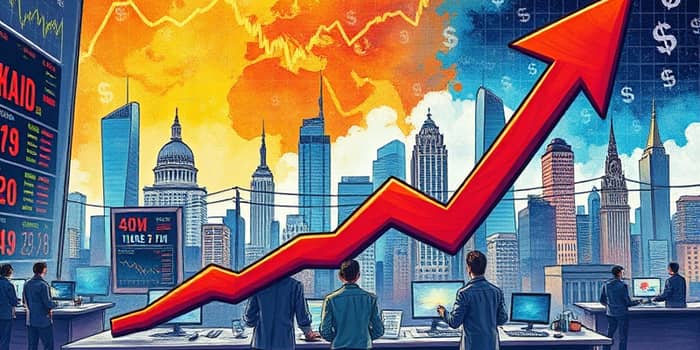Inflation touches every corner of the economy, reshaping returns and investor behavior. For equity markets, its rise can act as both a catalyst and a restraint.
Inflation’s Short-Term Impact on Equities
At its core, inflation represents the gradual loss of purchasing power through rising prices. When consumer costs accelerate, companies face higher input expenses that squeeze profit margins.
In the short run, investors often see an inverse relationship between inflation and stock prices. As inflation ticks up, share values may drop due to concerns over future earnings, prompting portfolio rebalancing.
Key mechanisms driving this dynamic include:
- Economic slowdowns reducing consumer spending and corporate revenues.
- Central banks raising interest rates to combat inflation, damping borrowing and investment.
- Lower real returns as nominal gains erode against rising inflation.
For instance, a portfolio earning 4% nominally delivers merely 3% real return if inflation is 1%. But at 5% inflation, that same 4% gain becomes a –1% real loss.
Nominal vs. Real Investment Returns
Nominal returns can mask true performance during inflationary periods. What investors feel most keenly are real returns over nominal gains—that is, the purchasing power left after adjusting for inflation.
This divergence explains why markets can look robust even when many households feel economic strain. The gap between 39% nominal increase and just 15% real growth since 2021 highlights the distorting effect of rising prices.
Sector and Company Variations
Not all businesses suffer equally. Companies with strong brand loyalty and pricing power to pass on cost increases often maintain profit margins. In contrast, low-margin industries struggle to absorb higher expenses.
Historical data shows certain segments fare better when inflation climbs:
- Consumer staples: essentials whose demand remains stable despite price changes.
- Energy and commodities: prices often move in tandem with broader inflation trends.
- Healthcare: essential services with regulated or inelastic pricing.
Meanwhile, highly competitive, low-margin sectors such as consumer discretionary or basic industrials may see sharper profit erosion under cost pressures.
Monetary Policy and Market Valuations
Central banks respond to rising inflation by increasing interest rates, which has a ripple effect through financial markets. Higher rates raise borrowing costs for companies and consumers, cooling economic activity.
An increase in policy rates also makes fixed-income investments more attractive relative to equities. As bond yields rise, stocks must offer higher future earnings to compete, leading to lower price-to-earnings multiples.
Empirical studies from the U.S. and Japan reveal how coordinated shifts in inflation, monetary policy, and market returns unfold across inflationary and deflationary cycles, influencing investor expectations.
Investor Sentiment and Behavioral Effects
Inflation doesn99t just affect balance sheets; it shapes psychology. Rising price levels heighten uncertainty, often reducing risk appetite and increasing market volatility.
Expectations of further central bank tightening can cause investors to sell equities preemptively, even when companies remain fundamentally sound. Conversely, stable, low inflation tends to boost confidence and encourage equity allocations.
Strategies for Inflation-Aware Investing
While inflation presents challenges, it also offers opportunities for disciplined investors. Key approaches include:
- Long-term diversified equity portfolio to ride out short-term volatility.
- Focus on inflation-resistant sectors like staples, energy, and healthcare.
- Monitor real (inflation-adjusted) returns rather than just nominal figures.
- Maintain balanced allocations including assets like commodities and inflation-linked bonds.
Sticking to a disciplined, long-term plan helps smooth out cycles and preserve purchasing power when inflation surges.
Broader Economic and Policy Considerations
Persistent high inflation undermines economic prosperity by eroding real incomes and savings. For policymakers, striking the right balance between growth and price stability remains critical to sustaining market confidence.
Fiscal spending, supply constraints, and global factors also feed into domestic inflation trends, underscoring the complex interplay between government policy, central bank actions, and market dynamics.
Conclusion: Embrace Inflation Awareness
Inflation is neither an anomaly nor a short-lived blip; it is an enduring economic force that investors must understand. Recognizing the gap between nominal and real returns, tailoring sector exposures, and staying attuned to monetary policy are essential steps toward building resilient, long-term portfolios.
By weaving inflation awareness into investment decisions, market participants can navigate turbulent periods with greater confidence and safeguard their purchasing power for the future.
References
- https://www.ig.com/en/trading-strategies/how-does-inflation-affect-the-stock-market-210423
- https://www.heritage.org/budget-and-spending/commentary/inflation-artificially-pumps-the-stock-market
- https://www.bankrate.com/investing/how-inflation-affects-the-stock-market/
- https://www.hartfordfunds.com/insights/market-perspectives/equity/which-equity-sectors-can-combat-higher-inflation.html
- https://digitalcommons.bryant.edu/cgi/viewcontent.cgi?article=1041&context=eeb
- https://www.investopedia.com/terms/i/inflation.asp
- https://public.com/learn/how-inflation-impacts-the-stock-market










